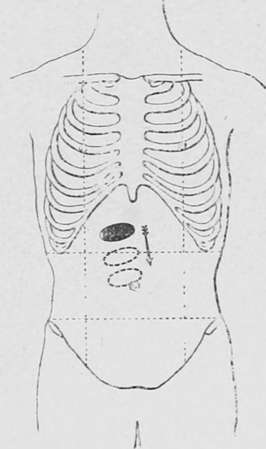Movement With Respiration
Description
This section is from the book "Cancer And Other Tumours Of The Stomach", by Samuel Fenwick. Also available from Amazon: Cancer and other tumours of the stomach.
Movement With Respiration
It is usually taught that a gastric tumour descends upon inspiration only when it is attached to the liver, the spleen, or the diaphragm. Such a statement, however, is totally at variance with fact; for unless adhesions exist which bind the organ to the abdominal wall, the pancreas, or the spine, a downward movement of the tumour with each inspiration can invariably be detected by the hand, if not by the naked eye. As a rule, the excursion is greatest in the female, owing to the displacement of the abdominal viscera which is so often produced by the pressure of corsets. It is also very marked in the subjects of emphysema. The change in the position of the tumour as the result of an inspiratory effort not only indicates its connection with one of the movable abdominal viscera, but also constitutes a valuable aid to its detection, since many growths of the lesser curvature and of the cardiac region of the stomach remain concealed by the ribs unless pushed downwards by a forcible contraction of the diaphragm. Moreover, if by pressure with the hand the tumour can be fixed at the lowest point in its excursion, so that it does not recede towards the chest during expiration, it is obvious that no adhesions exist between it and the liver or diaphragm. On the contrary, if this is impossible, and the tumour slips upwards despite every attempt to restrain it, the growth will always be found to be attached to some organ in connection with the diaphragm.

Fig. 40. - Showing the downward movement of the tumour upon inspiration.
Continue to:
